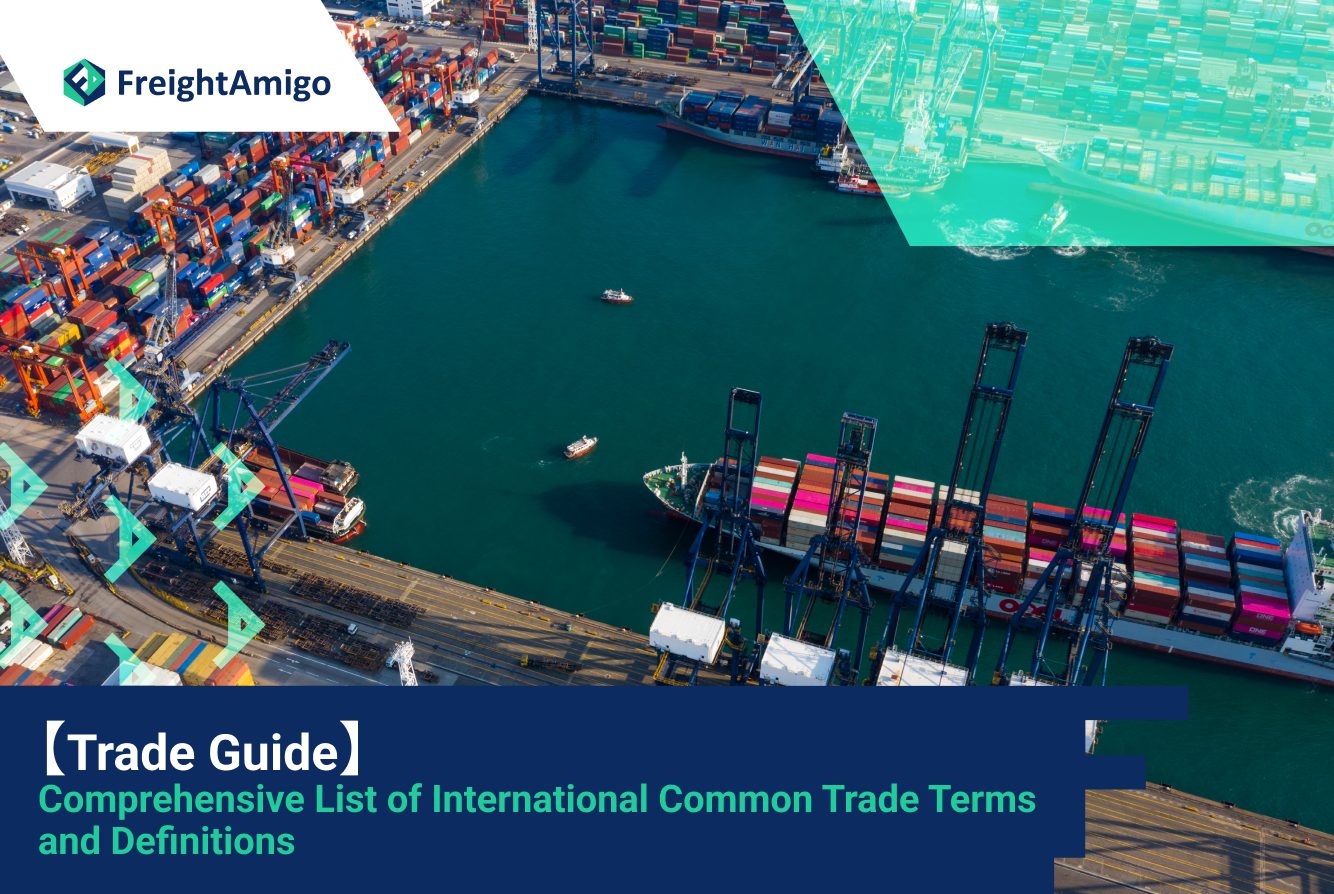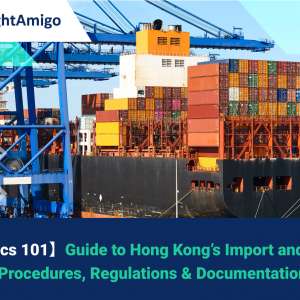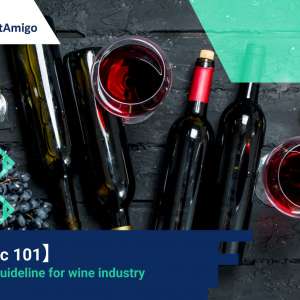Author Name:Tiffany Lee – Marketing Analyst at FreightAmigo
International trade, it is important to understand and master commonly used trade terms and abbreviations. These terms and abbreviations cover various aspects of trade, such as trade modes, transportation modes, payment methods, and more, and involve various links and processes of import and export trade. To help you better understand and master these important trade terms, FreightAmigo has prepared a comprehensive list of commonly used international trade terms, covering various aspects of trade terms and abbreviations. By learning and mastering these terms, you can smoothly conduct your trading business and avoid unnecessary troubles and losses caused by unclear terminology.
Want to compare the best Express, Air Freight, Sea Freight, Rail Freight & Trucking rates so as to have better control on cost?
Recent Developments in Hong Kong’s Economy and Commerce
In the fourth quarter of 2022, Hong Kong’s Gross Domestic Product (GDP) decreased by 4.2% in real terms compared to the same period of the previous year. For the whole year of 2022, the real GDP fell by 3.5% compared to 2021. The latest government forecast predicts a real GDP growth of 3.5-5.5% for Hong Kong in 2023.
In March 2023, the overall consumer price index rose by 1.7% compared to the same period of the previous year, the same increase as in February 2023. The government predicts that the basic consumer price inflation in Hong Kong will remain moderate in 2023, with an estimated annual inflation rate of 2.5%.
In February 2023, the nominal sales of the retail industry increased by 31.3% compared to the same month of the previous year. The total sales value of the retail industry in January to February 2023 increased significantly by 17.3% compared to the same period last year.
As local economic activities gradually resumed from the pandemic, the seasonally adjusted unemployment rate in Hong Kong decreased from 3.3% in December 2022 to 3.1% in January to March 2023.
After a year-on-year decline of 8.8% in February 2023, Hong Kong’s goods exports continued to narrow in March, with a 1.5% decrease compared to the same period of the previous year. Overall, the export value of goods in January to March 2023 decreased by 17.7% compared to the same period last year.
Hong Kong Trade – Policies
Hong Kong has always implemented a policy of free trade, so there are basically no trade barriers. Goods entering or leaving Hong Kong do not need to pay tariffs. The procedures for import and export visas are simple, and most goods can be imported or exported without the need for a permit. In cases where visas or declarations are required, it is only to fulfill different international commitments or for the sake of public health, safety, or security considerations.
The Trade and Industry Department of the Government of the Hong Kong Special Administrative Region is responsible for handling Hong Kong’s external trade relations, issuing certificates of origin, and issuing import and export licenses for textiles, strategic goods, and reserved commodities.
Currently, Hong Kong is a member of the following international trade organizations:
World Trade Organization (www.wto.org )
Asia-Pacific Economic Cooperation (www.apec.org )
Organization for Economic Cooperation and Development (www.oecd.org )
Pacific Economic Cooperation Council (www.pecc.org )
Hong Kong Trade – Customs Procedures
According to the Import and Export (Registration) Regulations, any person who imports or exports any goods (excluding exempted goods) must submit an import/export declaration form and pay ad valorem declaration fees and levies within 14 days after the goods are imported or exported. For information on the legal provisions and application procedures for Hong Kong’s customs declaration procedures for imports and exports, you can visit the website of the Hong Kong Customs or contact the Hong Kong Customs:
Telephone: 2852 3048
Fax: 2541 7739
Commonly used International Trade terms
CFR (Cost and Freight) | The seller contracts and pays the costs and freight necessary to bring the goods to the named destination and clears the goods for export. CFR is only used for sea and inland waterway transportation. The buyer undertakes the risk of loss or damage once the goods are delivered to a carrier. |
CIF (Cost, Insurance and Freight) | Apart from the same obligations in CFR, the seller must procure cargo marine insurance against the buyer's risks of goods during the carriage. The seller contracts for insurance and pays the insurance premium. |
CIP (Carriage and Insurance Paid To) | Apart from the same obligations in CPT, the seller must procure cargo insurance cover against the buyer's risks of loss of or damage to the goods during the carriage. The seller contracts for insurance and pays the insurance premium. CIP is used for any mode of transportation. |
CPT (Carriage Paid To) | The seller contracts and pays for the carriage of goods to the named destination and clears the goods for export. CPT is used for any mode of transportation. The buyer undertakes the risk of loss or damage once the goods are handed over to the first (or only) carrier. |
D/A (Documents Against Acceptance) | It is one of common payment methods for international trade. Exporters, via the remitting bank, instruct the banks (collecting bank via remitting bank) to release the title right and other shipping documents to the importers subject to acceptance of the accompanying bills of exchange or drafts by the importers. Exporters will face the higher risk. Non‑payment risk at maturity of the draft. |
D/C (Documentary Credit) | It is one of common payment methods for international trade. D/C (also called letter of credit) is an instrument issued by buyer's bank who undertakes to settle payment to the seller when the seller acts and fulfills all terms and conditions of the credit. |
D/P (Documents Against Payment) | Exporters instruct the banks (collecting bank via remitting bank) to release the title right and other shipping documents to the importers subject to payment. |
DAP (Delivered At Place) | The seller fulfills his obligations to deliver when the goods are ready for unloading from the arriving carrier by the buyer at the named place of destination, and cleared the goods for export. The seller bears all risks involved in bringing the goods to the named place. DAP is used for any mode of transportation. |
DAT (Delivered At Terminal) | The seller fulfills his obligation to deliver once the goods are unloaded from the arriving carrier at a named port terminal or place of destination, and cleared for export. The seller bears all risks involved in bringing the goods to and unloading them at the named place of destination. DAP is used for any mode of transportation. |
DDP (Delivered Duty Paid) | The seller fulfills his obligation to deliver when the goods are made available at the named place in the country of importation. The seller bears all risks and costs including import duties, taxes, delivery charges and clears for importation. DDP is used for any mode of transportation. |
ETA (Estimated Time of Arrival) | The projected date and time a shipment scheduled to arrive at its destination. |
ETD (Estimated Time of Departure) | The projected date and time a shipment scheduled to depart. |
EU (European Union) | An economic trade region in Europe comprising 28 members, namely Austria, Belgium, Bulgaria, Croatia, Cyprus, Czech Republic, Denmark, Estonia, Finland, France, Germany,Greece, Hungary, Ireland, Italy, Latvia, Lithuania, Luxembourg, Malta, Netherlands, Poland, Portugal, Romania, Slovakia, Slovenia, Spain, Sweden and United Kingdom. |
EXW (Ex Works) | The seller fulfills his obligation when he makes the goods available to the buyer at the seller's own premises or at another named place of delivery. The buyer bears all costs and risks involved in taking the goods from the place of delivery. EXW is used for any mode of transportation. |
FAS (Free Alongside Ship) | The seller fulfills his obligation to deliver when the goods have been placed alongside the vessel at the named port of shipment. Buyer bears all costs and risks of goods from that moment. FAS is used only for sea or inland water transportation. |
FCA (Free Carrier) | The seller fulfills his obligation when the goods are cleared for exports and delivered to the carrier or another person at the seller’s premises or another named place. FCA is used for any mode of transportation. |
FCL (Full Container Load) | A full container load means a container with goods from one consignor to one consignee. |
FOB (Free On Board) | The seller fulfills his obligation to deliver when the goods have passed over the ship's rail and cleared for exports, at the named port of shipment. Buyer bears all costs and risks of goods from that moment. FOB is used for sea and inland water transportation. |
GSP (Generalised System of Preference) | GSP is a framework under which developed countries give preferential tariff (a reduced or zero rate) treatment to manufactured goods from certain developing countries. |
HS (Harmonized System of Classification) | The HS code numbers are designed by the World Customs Organisation (WCO) to serve as a multi‑purpose classification suitable for use by customs and statistical authorities, traders, carriers and other concerned with international trade. Since 1 January 1992, Hong Kong has adopted the HS in full for trade declaration purpose. |
IATA (International Air Transport Association) | An international organisation of airline aiming to promote the commercial air traffic. |
ICC (International Chamber of Commerce) | ICC is a non‑government organisation of over 12,000 chambers and their business communities worldwide. It represents the world business community at international levels, promotes world trade and investment and provides a range of practical services to trade. |
IMDG Code (International Maritime Dangerous Goods Code) | An international guideline to the safe water transportation or shipment of dangerous goods or hazardous materials by vessel by the International Maritime Organisation. It contains advice on emergency procedures, packing of dangerous goods, labeling handling, etc. The guideline is recommended to governments for adoption or use as a basis for national regulations. |
INCOTERMS | INCOTERMS stand for international commercial terms. The Incoterms rules created by the International Chamber of Commerce are a set of uniform rules codifying the interpretation of delivery trade terms defining the rights and obligations of the exporter and importer in an international transaction. Examples include CIF, FOB, FAS, CFR, etc. |
L/C (Letter of Credit) | A common name of a documentary credit (D/C). |
LCL (Less than Container Load) | A less container load is a container with goods from more than one consignor to more than one consignee. |
MT (Mail Transfer) | A bank transfer made by mail, especially airmail, as opposed to a telegraphic or cable transfer. |
SITC (Standard International Trade Classification) | The SITC recommended by the United Nations for classifying trade statistics for economic analysis, is also used in trade statistics reports published by the Hong Kong Government. |
TEU (Twenty-foot Equivalent Unit) | A unit for calculating the carrying capacity of container vessels. The unit is based on the twenty foot container. |
TT (Telegraphic Transfer) | A remittance via the cable or telegraph sent from an instructing bank to the overseas bank. It is usually initiated by the debtor who instructs his banker by debiting his account to make payment to an identified person or firm in international trade. |
UCP (Uniform Customs and Practice for Documentary Credits) | Rules of the International Chamber of Commerce (ICC) governing a letter of credit issued in respect of goods shipped. |
UNCITRAL (United Nations Commission on International Trade and Law | UNCITRAL set up by UN Commission to aid in harmonising and unifying international trade law. The Commission focuses on four principal international areas: sale of goods, payments, commercial arbitration and legislation pertaining to shipping. |
Want to have more information on international trade-terms?
If you would like to have a better understanding and mastery of these important trade terms, FreightAmigo has compiled the following articles for your reference:
| FCA (Free Carrier) | 【Logistic101】What is FCA?| Meaning and Usage of Incoterms |
| CFS (Container Freight Station) | 【Logistics 101】Definition and Related Cost of CFS |
| CPT (Carriage Paid To) | 【Logistic101】What is CPT?| Usage and reminders of Incoterms |
| DDP (Delivered Duty Paid) | 【Logistic101】A Complete Guide to DDP and What You Should Know |
| EXW (Ex Works) | 【Logistics 101】Guide to the Meaning and Pros and Cons of EWX |
| FCL (Full Container Load) | 【Logistics101】Benefits and Drawback that you must know of FCL |
| FOB (Free On Board) | 【Logistics101】Understanding the Differences between FOB and Other Common Terms |
| TEU (Twenty-foot Equivalent Unit) | 【Shipping 101】 TEU= Twenty Feet Equivalent Unit? | The Measurement and Conversion of International Unit |
| THC (Terminal Handling Charge) | 【Logistics 101】Definition of Terminal Handling Charges (THC) and Its Calculation |
| CIP (Carriage and Insurance Paid To) | 【Logistic101】 CIP Meaning and Usage of Incoterms |
There are different options for cargo transportation. If you want to choose the most convenient and suitable solution, it is best to have the full support of logistics experts! If you are planning to ship goods overseas, please go to the FreightAmigo page for inquiries.
更多物流資訊:
【Logistics 101】Guide to Hong Kong’s Import and Export Procedures, Regulations & Documentation
【Logistics 101】Learn About ISF and Important Considerations in One Article!
【Logistic 101】What is Palletized? Functions and types to know
===
If you have any inquiries on logistics/supply chain, feel free to contact FreightAmigo now:
Chat with us online OR
Phone : +852 28121686
WhatsApp: +852 27467829









































